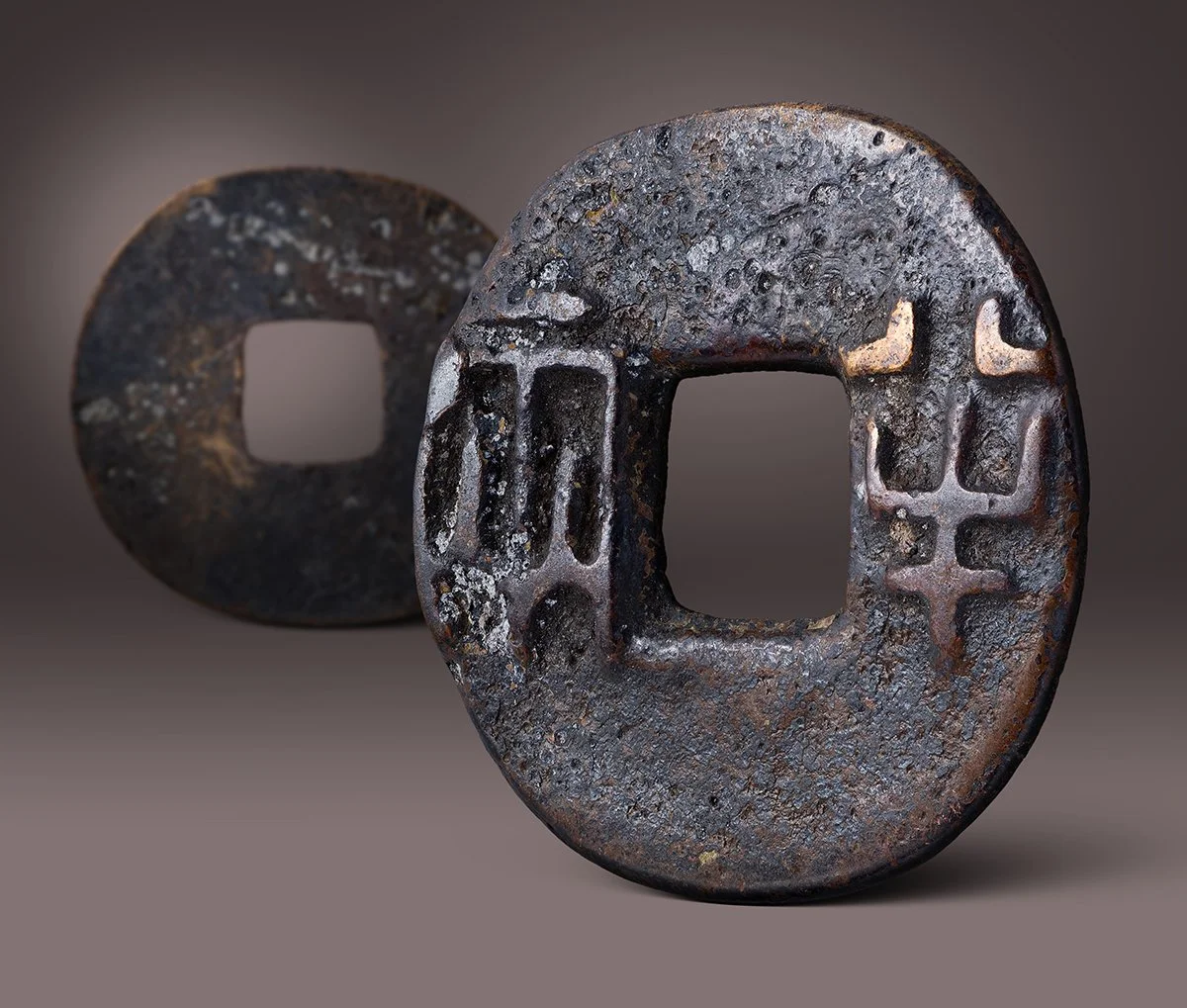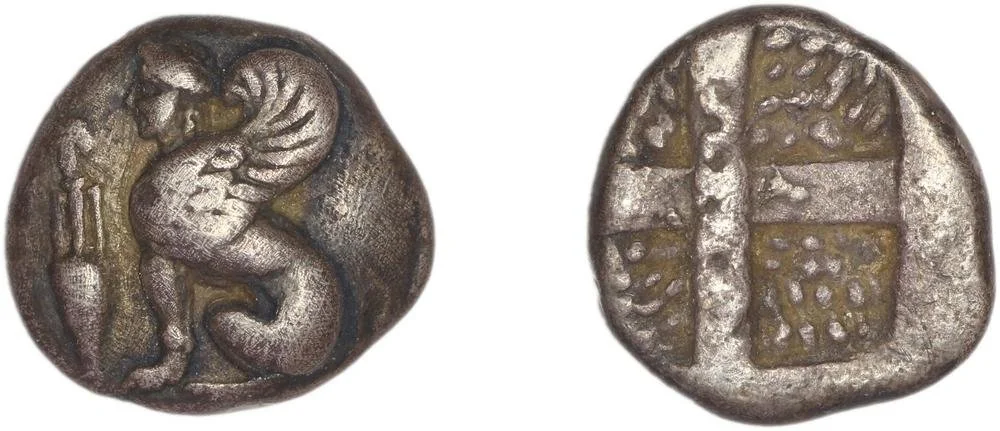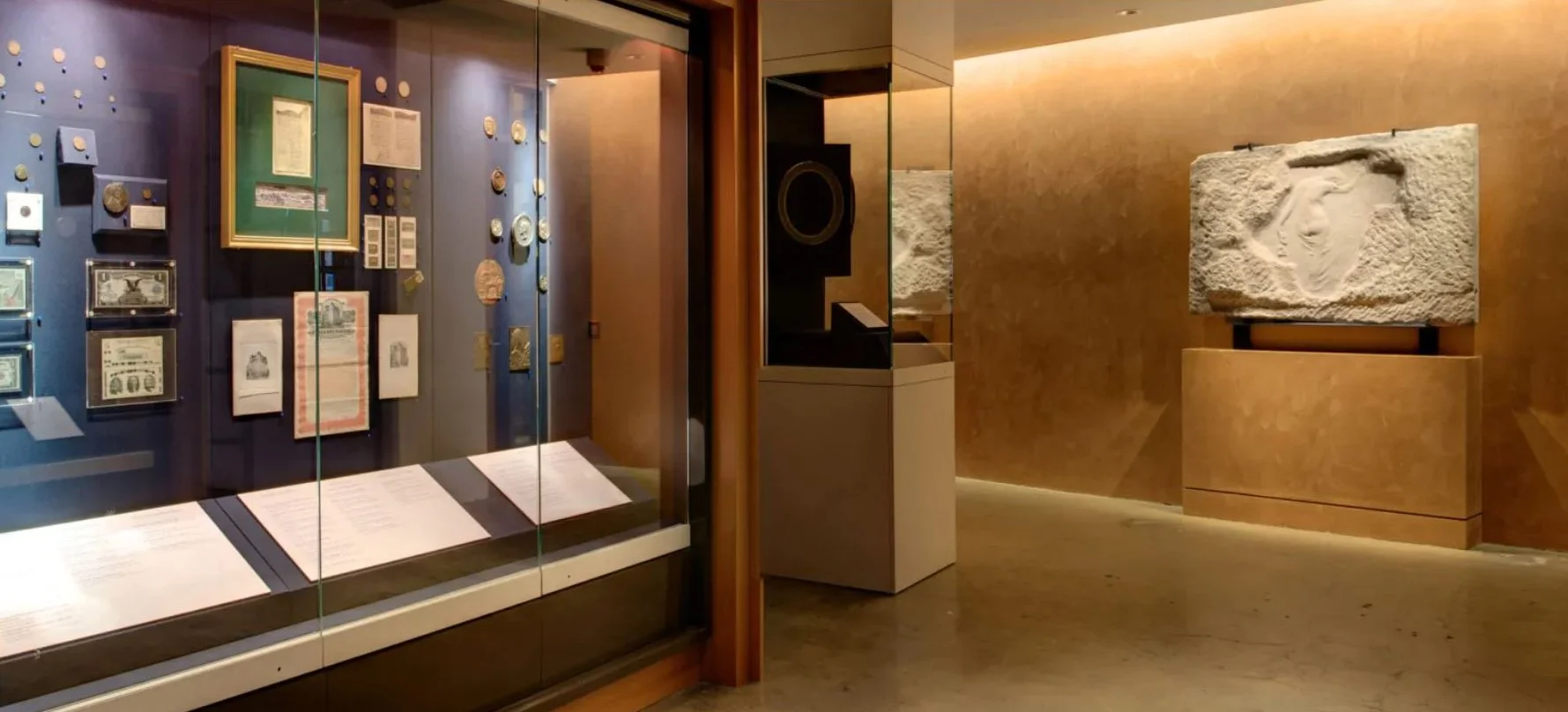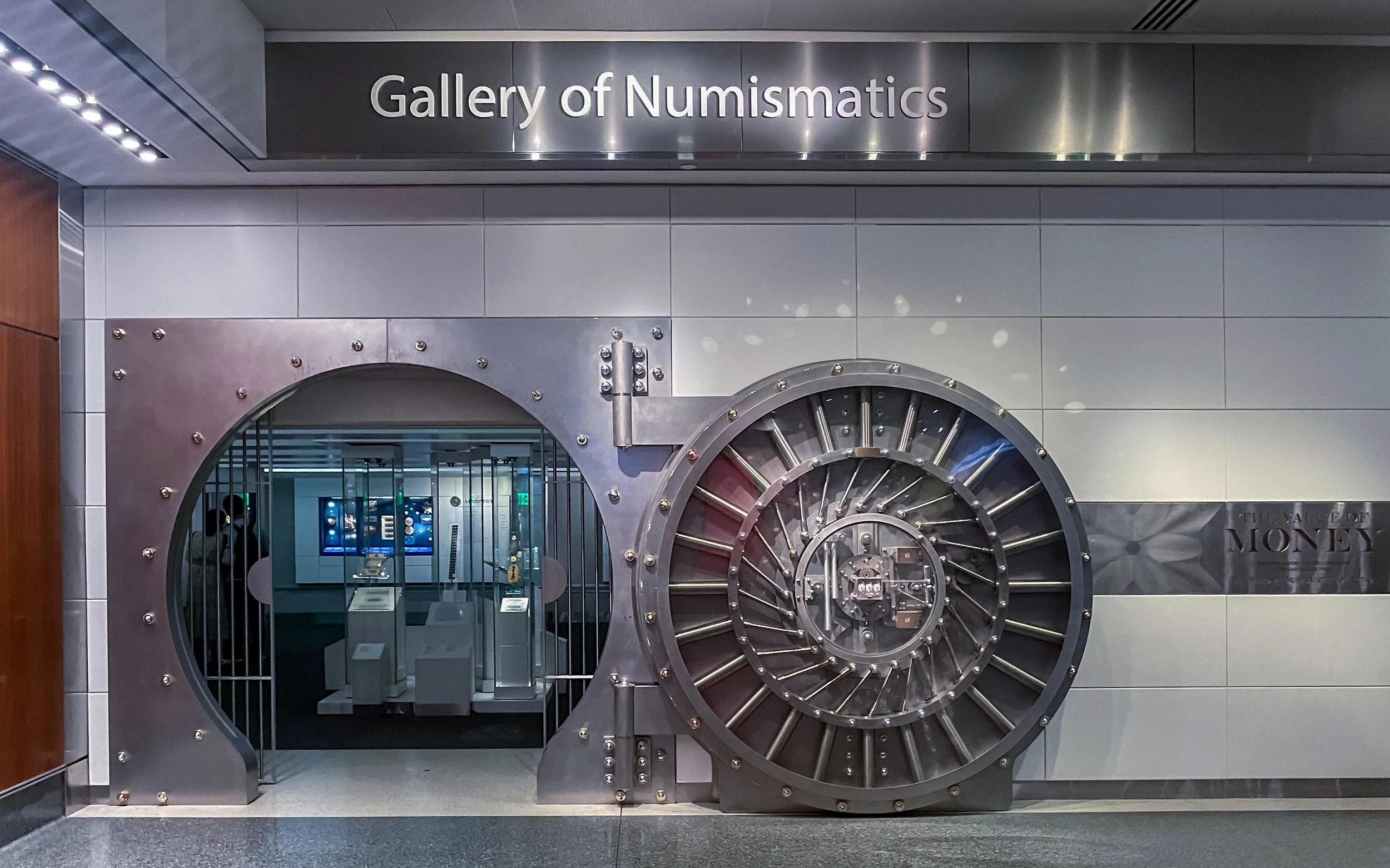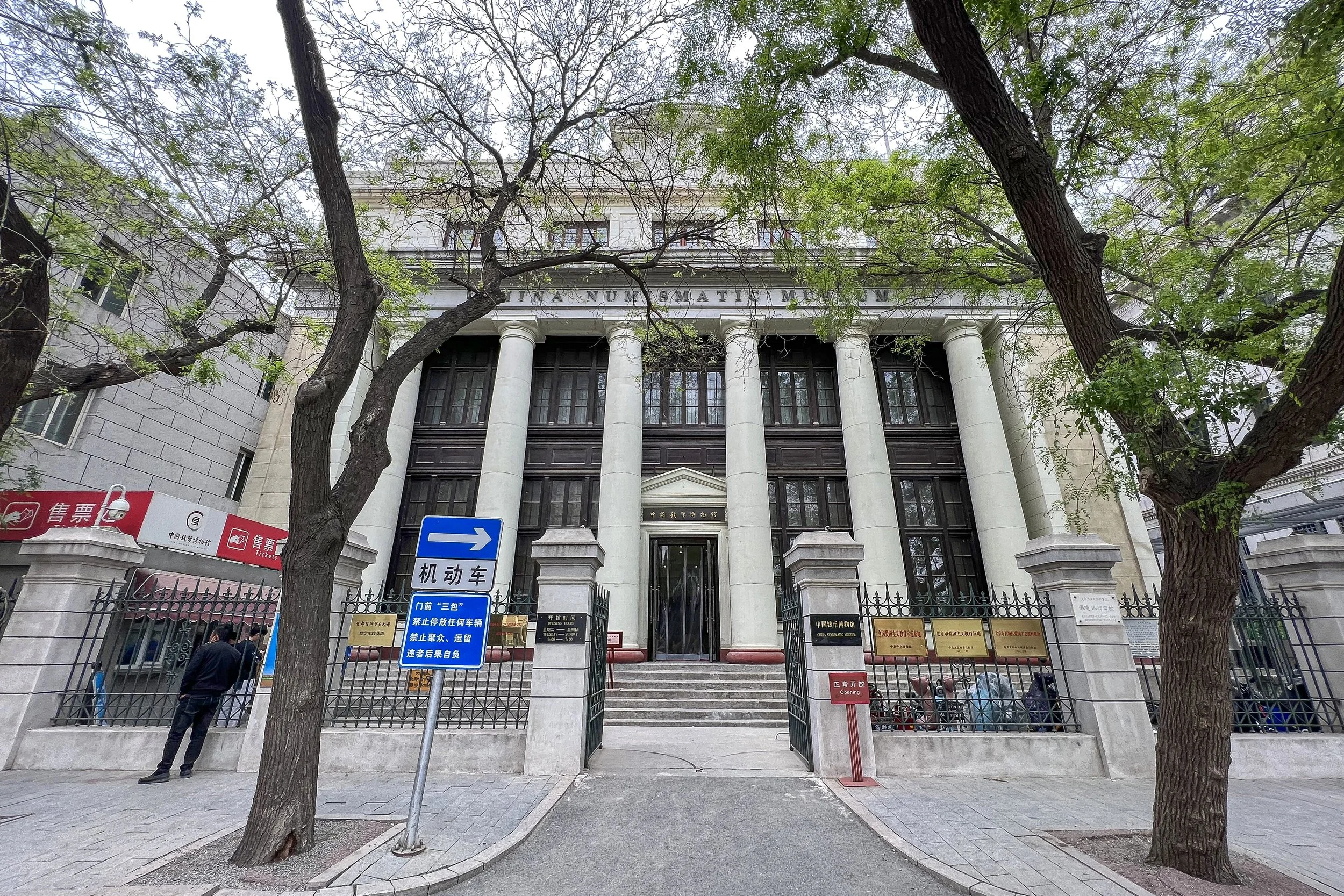Top 10 Museums with Remarkable Numismatic Collections
By Denis Richard, Coin Photography Studio
May 10, 2025
8-minute read
During a recent visit to the Royal Ontario Museum numismatic department, I had the pleasure of photographing a rare Ban Liang coin for my upcoming book. Between shots, in the quiet of the museum’s numismatic storage area, I couldn’t help but reflect on how many coins were in there, tucked away in the drawers and shelves that surrounded me, far from public view. Like many institutions, the ROM exhibits only a small portion of its collection—its public galleries barely hint at what’s preserved behind closed doors.
Ban Liang
Cast in China over 2,000 years ago, the Ban Liang is considered the East’s earliest round coin—a foundational piece in the evolution of currency. This Ban Liang is one of many tucked away in the Royal Ontario Museum’s renowned Asian collection.
It left me wondering: Which museums around the world hold the most remarkable numismatic collections?
The article that follows explores ten museums that stand out for their extraordinary coin cabinets. Each of these institutions boasts an immense collection, historically significant pieces, and unique ways of showcasing the story of money. I hope to visit all of them one day.
British Museum (London, UK)
A Million Coins Spanning World History
The British Museum’s Department of Coins and Medals holds almost one million numismatic objects – one of the largest such collections globally. This vast assemblage includes coins, medals, tokens, and paper money from the 7th century BC to the present day, covering both Eastern and Western numismatic traditions. In other words, the collection traces the entire history of coinage, from some of the earliest known coins of ancient Lydia to modern currency.
Such breadth means you can find treasures from virtually every era and region. The British Museum has superb holdings of classical coins (Greek and Roman), treasures of the medieval world, and coins from Asia, Africa, and the Americas. Notably, British history is richly represented – the Museum has benefited from the UK’s Treasure Trove law that allows it to acquire hoards of gold and silver coins unearthed in Britain. For example, the famous 15th-century Fishpool Hoard of gold coins (recovered in 1966) is one of many coin hoards now in its care. Visitors can view around 9,000 highlights on display, including in the dedicated Money Gallery (Gallery 68). From ancient Greek Athenian owl tetradrachms to Victorian pennies, the British Museum’s numismatic collection offers a panoramic view of world history through money.
A silver drachm from ancient Greece, circa 375 - 350 BCE, from the museum’s collection. Image © The Trustees of the British Museum. Shared under a Creative Commons Attribution-NonCommercial-ShareAlike 4.0 International (CC BY-NC-SA 4.0) licence.
Aerial view of the British Museum in 2015. Image courtesy of the British Museum, via https://en.wikipedia.org/wiki/British_Museum
If the British Museum represents the breadth of world coinage, Paris’s Cabinet des Médailles exemplifies the deep historic roots of coin collecting in Europe.
Bibliothèque Nationale de France – Cabinet des Médailles (Paris, France)
Treasures of Kings and Empires
The Cabinet des Médailles of the Bibliothèque nationale de France (BnF) is one of the oldest numismatic collections, with origins in the medieval French kings’ treasure. Today it contains about 450,000 coins and tokens, plus 150,000 medals, among many other antiquities. This collection was originally the private coin cabinet of French royalty – augmented over centuries and saved from dispersal during the Revolution. As a result, it holds coins from ancient Greece and Rome, medieval and modern Europe, and particularly coins of the French monarchy (around 6,000 gold, silver, and billon coins from Hugh Capet to Louis XVI, including famous royal issues).
Unique and historically significant items abound. For instance, the Cabinet des Médailles owns the spectacular ancient coin known as the 20-stater of Eucratides I – a Bactrian Greek gold coin weighing 169 grams, reputed as the heaviest gold coin of antiquity. This massive coin, a unique piece (“numismatic monster” as it was nicknamed), was acquired by Emperor Napoleon III for France’s coin collection in 1867. The cabinet also preserves the Treasure of Gourdon (a 6th-century Frankish gold hoard) and many exquisite Roman coin medallions. Housed in Paris’s Richelieu Library, the Cabinet des Médailles offers an intimate gallery where one can admire these riches – coins and medals that once passed through royal hands or ancient marketplaces. From classical Greek decadrachms to Napoleon’s currency, this collection reflects Europe’s history in miniature form.
The Cabinet des Médailles, a distinguished department of the Bibliothèque nationale de France in Paris. With roots tracing back to the royal treasuries of the French monarchy, it is regarded as France’s oldest museum. The earliest documented numismatic photograph, produced in 1849 by Hippolyte Fizeau, captured plaster casts of Roman coins housed in the Cabinet des Médailles. Image by Jean-Pierre Dalbéra, from https://www.flickr.com/photos/dalbera/ . Used under fair use for illustrative purposes.
Traveling east from France to Germany, we find another of Europe’s greatest coin troves – one so large it spills across several museums on Berlin’s Museum Island.
Münzkabinett, Berlin (Germany)
A Half-Million Coins in a Prussian Coin Cabinet
Berlin’s Münzkabinett (Coin Cabinet), part of the Staatliche Museen zu Berlin, houses over 500,000 objects in its numismatic collection. This makes it one of the largest coin collections worldwide, renowned for the incredible variety and continuity of its holdings. The collection ranges from the dawn of coinage in the 7th century BC (the era of Lydia in Asia Minor) to coins and medals of the 21st century. Such an unbroken series means Berlin’s cabinet can illustrate the development of money through every era.
The depth of the Münzkabinett’s collection is impressive. Among its approximately half-million pieces are about 102,000 ancient Greek coins and 50,000 Roman coins, 169,000 European coins from the Middle Ages and modern era, and 30,000 Islamic and Oriental coins, not to mention 32,000 medals. It also preserves thousands of historical coin-making dies and seals. This spectrum covers everything from Athenian silver drachmas to Prussian thalers, Islamic dinars, and German euros.
One unique aspect of Berlin’s coin cabinet is how it’s exhibited: the Münzkabinett’s treasures are so extensive that they are displayed in multiple museums. The primary display is in the Bode Museum, where a selection of 5,000 coins and medals has been on view since 2006. Additionally, ancient coins complement the classical antiquities in the Altes Museum, and other pieces enrich exhibits in the Neues Museum and Pergamon Museum. This integration showcases coins in context with art and history collections. Whether you’re examining a rare medieval bracteate coin or a Renaissance portrait medal, Berlin’s Münzkabinett provides an encyclopedic look at monetary history, continuing the tradition of the Prussian kings who began assembling these coins centuries ago.
The vault at Münzkabinett, Berlin. Image by Grosser Tresor, from https://ikmk.smb.museum/home?lang=en
Another Central European capital, Vienna, also boasts an imperial coin cabinet of immense scope – one with roots in the 16th-century Habsburg dynasty.
Kunsthistorisches Museum – Coin Cabinet (Vienna, Austria)
Imperial Habsburg Hoard
Vienna’s Kunsthistorisches Museum (KHM) is famed for art, but it also guards one of the world’s five largest coin collections. The KHM’s Coin Cabinet grew out of the Habsburg emperors’ collections (the oldest inventory dates to 1547). Today it contains about 600,000 objects spanning three millennia. This range is breathtaking: it includes not only coins of all ages but also pre-monetary currency forms, banknotes, stock shares, medals, orders, and even minting tools. In essence, Vienna’s collection covers the entire evolution of money and medallic art, reflecting the Habsburgs’ far-reaching empire and interests.
Only a fraction of this vast hoard is on display – roughly 2,000 pieces exhibited in three galleries – but they offer a rich sample. Gallery I, for example, traces the history of the medal as an art form from 1400 onward, showcasing Renaissance masterpieces, while Gallery II focuses on the history of coins and paper money, featuring ancient Greek, Roman, and medieval coins alongside early Austrian currency and banknotes. You might see anything from a Byzantine gold solidus to a Maria Theresa thaler, or even earlier forms of money like ancient Chinese knife coins and Pacific island shell money (since the collection includes some pre-coinage currencies). The presence of original minting dies and equipment adds another dimension – one can literally see how coins were made in past eras.
A unique strength of the KHM Coin Cabinet is its accumulation of rare and historically important coins from the Habsburg domains and beyond. Emperors and scholars over centuries poured treasures into this collection. For instance, it holds superb sequences of ancient Roman coins gathered during the Renaissance, medieval coins from across Europe, and an extensive array of Austrian coins and medals that reflect the empire’s history. In Vienna, these objects are displayed in the majestic Kunsthistorisches Museum, allowing visitors to appreciate numismatics in an art historical context – truly where art and currency intersect.
The Coin Cabinet is located on the second floor of the Kunsthistorisches Museum. The exhibition showcases high-quality exhibits set against an impressive backdrop of historical furnishings. Image courtesy of the Kunsthistorisches Museum – Coin Cabinet via https://www.khm.at/en/exhibitions/muenzkabinett#:~:text=The%20Coin%20Cabinet%20is%20located,set%20amidst%20impressive%20historical%20furnishings
Heading north to Scandinavia, we find that Sweden too built up a colossal coin collection – one now known not just for coins but for illuminating the history of economies.
The Royal Coin Cabinet – Economy Museum (Stockholm, Sweden)
Sweden’s Numismatic Legacy
Sweden’s Royal Coin Cabinet (now part of the Economy Museum, Ekonomiska museet) is a repository of about 650,000 objects, including coins, banknotes, medals, and financial documents. With origins dating back to 1572, it is one of Sweden’s oldest museums and was historically the collection of the Swedish kings. Over the centuries it grew into a comprehensive archive of monetary history, not only for Sweden but for the world. Today the museum presents money in a broad economic context, but its numismatic core remains extraordinary in scale and content.
What’s particularly engaging about Stockholm’s coin collection is the unique items it contains. Among the notable objects on display are:
The world’s largest coin – a massive 10 daler copper plate money from 1644 (weighing about 19.7 kg!). This gigantic rectangular coin, issued under Queen Christina, dramatically illustrates the lengths to which a country went when coins were made of copper instead of gold or silver. (Visitors can even try to lift a replica – a true test of strength and history.) Image source: American Numismatic Association, https://www.money.org/tales-from-the-vault-swedish-plate-money-too-heavy-to-steal/ used for educational and commentary purposes.
Sweden’s first banknotes, issued in the 1660s by Stockholm Banco. These were among the earliest paper currencies in Europe, introduced to alleviate the impracticality of those heavy copper coins. Seeing these fragile, centuries-old paper notes shows a key innovation in monetary history.
A Rai stone from Yap – a large stone disc used as money on a Pacific island. This exotic piece underscores the museum’s global scope, demonstrating that money isn’t just metal and paper – it can even be giant stone currency when society agrees on its value.
Other treasures include the Lohe treasure, a hoard of silver coins buried in the 18th century, and stock certificates from the 18th-century Swedish East India Company, linking coins to commerce. The museum’s approach connects such artifacts to broader economic themes. Interactive exhibits (like a Bitcoin ATM and economic games) stand alongside cases of Viking silver coins or World War II ration coupons. This mix of old and new makes the Royal Coin Cabinet’s exhibits especially accessible. Overall, Sweden’s national numismatic collection is not only vast in number but rich in storytelling – from the heaviest coin ever circulated to the earliest experiments in paper money, all under one roof.
Now, leaving Europe, we cross to Eastern Europe and Asia Minor – specifically to Russia’s former imperial capital – where the Hermitage Museum holds an unparalleled collection reflecting the might of the tsars.
State Hermitage Museum (St. Petersburg, Russia)
The Tsar’s Grand Coin Collection
The Hermitage Museum in St. Petersburg is famed for art, but it also holds a numismatic collection of staggering size – over 1.1 million coins and currency items. This collection, forming roughly one-third of the Hermitage’s total objects, was largely built during the Russian Empire. Czar Peter the Great kick-started it in 1722 by decreeing that all old Russian coins be confiscated into a state collection. Empress Catherine the Great enthusiastically expanded it with purchases of ancient coins and medals to rival other European courts. The result today is a numismatic trove exceeding one million pieces covering every corner of the globe.
Major sections of the Hermitage’s collection include ancient coins, Western European coins, Oriental (Asian) coins, and Russian coins/medals. To highlight a few of its wonders: the Hermitage has an astonishing assemblage of ancient Greek coins – over 63,000 pieces – with particular strengths in coins from the Northern Black Sea region (Greek colonies on what is now Ukrainian and Russian coasts). Among these are numerous masterpieces, such as a renowned silver decadrachm of Syracuse signed by the artist Kimon, prized as one of the most beautiful ancient coins. The collection of classical coins also includes one of the world’s largest groups of Alexander the Great’s coinage and extensive Roman and Byzantine coins.
The Oriental numismatic section of the Hermitage is among the world’s most extensive, boasting over 200,000 items from Asia and the Middle East. This features everything from ancient Persian darics and Central Asian medieval coins to Chinese ingots and Islamic coins, plus unusual forms like coin-shaped amulets and primitive currencies of Africa. Of course, the Hermitage also contains the comprehensive series of Russian coins and medals, reflecting the currency of the Russian Empire and earlier. Visitors can see coins minted by every czar, medals awarded by the imperial court, and currency notes from the era of the Ruble’s introduction onward. One can imagine the pride of the czars in amassing such a collection as a symbol of cultural prominence.
In modern times, the Hermitage’s numismatic collection has been made more accessible, including via an extensive digital catalog. Still, standing in the Hermitage’s coin galleries, you get a sense of both the enormous scope of the collection and the imperial history behind it. It’s a place where a tiny ancient coin or a gilded Catherine the Great medal each tell part of a vast monetary story, curated by centuries of Russian collectors.
Hermitage Museum in Saint Petersburg. Photo by Pedro Szekely, licensed under CC BY-SA 4.0 via Wikimedia Commons. https://upload.wikimedia.org/wikipedia/commons/f/f2/Hermitage_Museum_in_Saint_Petersburg.jpg
Next, we turn to the very birthplace of coinage in the Western world – Greece. Athens’s Numismatic Museum may not be as large as the Hermitage, but it rivals these others in significance with its focus on ancient coins in their homeland.
Numismatic Museum of Athens (Athens, Greece)
Coins of the Ancient World and Beyond
Fittingly for Greece, where coinage began over 2,600 years ago, Athens is home to a massive collection of about 500,000 coins, medals, and related artifacts spanning from c.1400 BC to modern times. The Numismatic Museum of Athens is often cited as one of the richest coin collections in the world, on par with those of London, Paris, Berlin, and New York. What sets it apart is its concentration of ancient Greek and Roman coins in the very soil where many were first minted, along with Byzantine, Medieval, and modern Greek coins that together trace an unbroken monetary history of Greece.
The museum’s coin holdings cover the entire Greek world: from the early electrum and silver coins of archaic Ionia and classical Athens, to Hellenistic coinages of Alexander the Great’s successors, to the coins of the Roman Empire that circulated in Greek lands, and onward through Byzantine gold solidi and Ottoman and modern-era coins used in Greece. For example, you can find classical Athenian tetradrachms (with the famous owl of Athena), coins of Philip II of Macedon and Alexander’s empire, rare coins of ancient kingdoms like Bactria, as well as coinage of the Byzantine emperors who ruled from Constantinople. Beyond ancient times, the collection features currency of the independent Greek state from the 19th century and commemorative coins of the modern era, reflecting Greece’s continuous history.
What makes a visit here especially engaging is how the museum presents these coins. Housed in the Iliou Melathron (the neoclassical mansion of archaeologist Heinrich Schliemann), the museum uses thematic displays in beautifully restored rooms rather than endless rows of coins. Exhibits explain the origins of money, the development of coin production, and the use of coins in everyday life. For instance, one room displays actual ancient coin hoards: clay jars and pots that were once filled with coins and buried for safekeeping. Visitors can see several hoards of Greek silver coins (with their original containers), vividly illustrating how people used and hid money in antiquity. There’s even a unique bronze coin minting die for Athenian tetradrachm coins, found in Egypt – evidence of ancient counterfeit or local mint production – which is a rare artifact showing how coins were struck.
Such features make the Athens Numismatic Museum an educational experience as much as a dazzling display of gold and silver. Standing in Schliemann’s ornate former dining room, you might gaze upon coins that passed through the Agora of Athens 2,500 years ago. The combination of an atmospheric setting, rich Greek and Roman collections, and innovative exhibits truly brings ancient economies to life. For any history or coin enthusiast, this museum is a gem where the stories of coinage from antiquity onward are told on their home turf.
Iliou Melathron, designed by Ernst Ziller and built in 1881, is the former house of Heinrich Schliemann and now houses the Numismatic Museum of Athens. Photo by C messier, licensed under CC BY-SA 4.0 via Wikimedia Commons.
Shifting from the Old World to the New, we head to the United States, where two institutions stand out for their colossal and diverse numismatic collections – one a public national collection, the other a scholarly society’s hoard.
American Numismatic Society (New York, USA)
Scholarly Collection of Nearly a Million Coins
Founded in 1858, the American Numismatic Society (ANS) in New York City is both a museum and a research institute devoted entirely to coins and currency. Over more than 160 years, it has assembled a collection encompassing nearly one million items – including coins, paper money, tokens, and medals from all cultures and periods. This makes the ANS one of the largest and most comprehensive numismatic collections in the world. Importantly, it is the premier research collection in the United States, accompanied by the world’s most comprehensive numismatic library with over 100,000 volumes of books and journals on money.
The ANS collection is encyclopedic. It ranges from ancient Greek, Roman, and Byzantine coins, to Far Eastern coins, Islamic coins, medieval and modern European issues, African and Latin American coins, and of course a vast array of United States coins and currency. For example, an ANS visitor or researcher can examine a rare Athenian decadrachm, a Song dynasty Chinese note, a colonial American coin, or a 20th-century U.S. banknote – the Society covers all these under one roof. Some highlights include extensive holdings of ancient Greek coins (tens of thousands, forming one of the best such collections outside Europe), and American rarities such as colonial coins and Confederate currency. The Society has also been the repository for significant donations and bequests; over time it absorbed famous collections like the U.S. Mint collection of Latin American coins and the Chase Manhattan Bank money collection, further enriching its diversity.
While the ANS’s primary focus is research (its vaults are a frequent stop for scholars and authors studying coins), it does showcase portions of its collection to the public through exhibitions. Its headquarters in Manhattan features rotating exhibits and it lends objects to other museums as well. The Society’s mission is not only to preserve these objects but to advance knowledge about them – it publishes academic journals and books, and offers educational programs. This makes the ANS unique: it’s a museum where behind the scenes, coins are being studied and catalogued to unlock history. In essence, the American Numismatic Society is a treasure trove for coin collectors and historians alike, preserving everything from ancient Athenian drachmas to modern-day currency, and ensuring that the legacy of money is studied and appreciated as an integral part of human history.
The American Numismatic Society maintains one of the world’s premier numismatic collections. Image courtesy of the American Numismatic Society, via https://numismatics.org/about-us/visiting/
Our final stop is Washington, D.C., where the U.S. National Numismatic Collection holds some truly legendary pieces of American monetary history – including currency so rare and high-denomination that it never circulated among the public.
National Numismatic Collection, Smithsonian (Washington, D.C., USA)
America’s Coinage Heritage on Display
The National Numismatic Collection (NNC) at the Smithsonian Institution is the United States’ official coin cabinet – and it is enormous. Comprising approximately 1.6 million objects, it ranks among the world’s largest and most diverse collections of money. Housed at the Smithsonian’s National Museum of American History, the NNC includes coins, paper currency, medals, tokens, commodity money, financial instruments, and exonumia (miscellaneous monetary objects). It is effectively the archive of U.S. monetary history: it holds the collections of the U.S. Mint and the Bureau of Engraving and Printing, as well as many donated private collections.
The scope of this collection is global and spans centuries, but its crown jewels are the items connected to American history – many of them one-of-a-kind. The NNC boasts some of the most famous and elusive U.S. coins ever made. For instance, it holds an example of the legendary 1849 Double Eagle, the first $20 gold coin struck by the U.S. Mint (only two were ever made; one resides here). It also contains not one but two of the 1933 Saint-Gaudens Double Eagle gold coins, among the most fabled rarities in the world (these $20 coins were never issued due to the gold recall, and most were melted down). In addition, the collection includes one of the five existing 1913 Liberty Head nickels and all three types of the famed 1804 silver dollar, known as the “King of American Coins”.
On the paper money side, the Smithsonian’s collection is unparalleled. It has, for example, the only $100,000 banknote ever released – a 1934 gold certificate featuring Woodrow Wilson. (This extremely high-denomination note was used only for transfers between Federal Reserve banks and never circulated publicly, but it’s a spectacle to see in person.) The NNC also preserves Colonial and Confederate currency, pioneer gold coins, patterns and proofs of experimental money, and currencies from around the world. The diversity is such that the NNC is described as “one of the world’s largest and most diverse collections” of money.
The Smithsonian showcases a selection of these treasures in its “Value of Money” exhibit, where visitors can marvel at items like a 7th-century Chinese coin, a large Yap stone, or a 1974 aluminum penny prototype, all in one place. The exhibit and collection underscore how money can be both an object of utility and a piece of art or history. From a wampum belt to a platinum Soviet coin, from ancient coins of the Bible to the paper notes in our wallets, the National Numismatic Collection bridges all these together. It’s a must-visit for anyone fascinated by currency – seeing a $100,000 bill or a gold double eagle in person truly drives home the historical journey of money in society.
The National Numismatic Collection is the national coin cabinet of the United States. The collection is part of the Smithsonian Institution's National Museum of American History. Photo by ajay_suresh, licensed under Attribution 2.0 Generic, via Wikimedia Commons.
China Numismatic Museum (Beijing, China)
The Story of Money in the Middle Kingdom and Beyond
Last but not least, we visit Beijing’s China Numismatic Museum, which offers an Asian perspective on numismatic history. Located just off Tiananmen Square in a former bank building, this national museum holds over 300,000 currency objects. Its collection, managed by the People’s Bank of China, is dedicated to the money and banking heritage of China – a country that not only used coins for over two millennia but also invented paper money. The galleries here showcase a panorama of Chinese numismatics from ancient to modern times, alongside comparative displays of world currency.
The exhibits are organized both chronologically and thematically. In the central hall, visitors learn about the origins of currency and the distinguishing features of Eastern vs. Western monetary systems. One highlight is the display of ancient Chinese money: China’s early coinage wasn’t round – it included bronze knife-shaped and spade-shaped coins from the pre-Qin era (circa 500–300 BC). The museum features these intriguing pieces (for example, the Qin State’s Ban Liang coins and various types of knife money are shown). As coinage unified and evolved, the collection follows through the Imperial Chinese dynasties – showcasing coins from the Han, Tang, Song, Yuan, Ming, and Qing periods. The Song dynasty’s pioneering paper banknotes and the Yuan dynasty’s extensive paper currency are a special point of pride, given that China was the first in the world to use paper money widely. These fragile, centuries-old notes can be seen in the museum’s rare currency gallery.
Besides imperial coinage, the China Numismatic Museum holds coins of China’s ethnic minorities and coins issued by various regimes in China’s turbulent modern era (1930s–1940s) – such as the currencies of different warlord governments and the early Communist soviet banknotes. The museum even displays the currency of over 100 other countries (mostly 19th–20th century gold and silver coins and paper notes) for a global context. This international section, along with exhibits on topics like ancient coin casting techniques and anti-counterfeiting measures, helps connect China’s monetary story with the wider world.
Unique artifacts include coin molds and dies used in Chinese mints, shining a light on how those round hole-punched coins were cast in clay and metal. The museum also features modern pieces, such as the progression of renminbi banknotes of the People’s Republic and special commemorative coins issued by the central bank. In sum, the China Numismatic Museum provides a comprehensive journey through China’s monetary civilization – from the bronze knives that might have been in a Qin merchant’s purse, to the world’s first paper currency carried by a Song-era trader, all the way to contemporary banknotes and even a display about digital currency. For visitors, it’s a chance to see treasures like ancient coins inscribed with Chinese characters, beautifully printed antique notes, and even foreign coins that found their way into China – each item a small witness to the grand narrative of China’s economic history.
China Numismatic Museum in Beijing, China.Photo by N509FZ, licensed under CC BY-SA 4.0 via Wikimedia Commons. https://en.wikipedia.org/wiki/China_Numismatic_Museum#/media/File:China_Numismatic_Museum_(20230423131153).jpg
While reading about rare coins can ignite curiosity, and seeing high-quality photographs brings their artistry into sharper focus, nothing compares to standing in front of the real thing. These ten museums represent the pinnacle of numismatic collections worldwide.
For collectors, historians, or anyone fascinated by the intersection of art, power, and commerce, these museums don’t just preserve coins; they give them context, presence, and life. If you’re even a little curious about the story of money and the people who used it, these are the places worth visiting.
A Final Thought
Thank you for reading this blog post! I hope you found it informative and enjoyable.
If you're interested in similar topics, be sure to check out our other posts on numismatic subjects. From coin history to coin photography, we have lots to offer.
Don't forget to leave a comment below with your thoughts and feedback. We love hearing from our readers and it helps us improve our content.
Thank you again for your support and we hope to see you back here soon! Happy collecting!
Sources: The facts and figures in this article are based on information from museum websites, numismatic references, and the Wikipedia page “List of museums with numismatic collections.” Key details about collection sizes and highlights can be found in references like the British Museum Department of Coins and Medals overview en.wikipedia.org, the CoinsWeekly articles on the Paris and Vienna collections new.coinsweekly.com, the official Berlin Münzkabinett site smb.museum, and data from the Smithsonian en.wikipedia.orgen.wikipedia.org, among others. These sources document the scale and significance of each museum’s numismatic holdings as summarized above.

